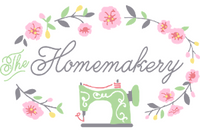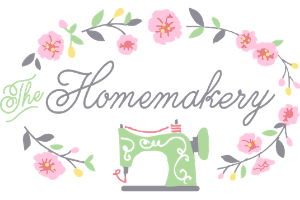
Hi, its Nicki here and I am delighted to have the opportunity to blog here at The Homemakery. Kate’s online shop is our go-to fabric supplier here at homebird and belle – Kate’s taste in all things crafty is faultless and I could spend all of my time and money browsing this super pretty site (and often do).
Today I am sharing a zipped pouch tutorial with a simple patchwork pattern using the gorgeous Tilda Happiness is Handmade collection.
I have made several of these pouches in various sizes. They are perfect for storing and transporting any WIPs but also brilliant for keeping all kinds of things organised in your handbag, like make-up or those odd bits and pieces that float around at the bottom of your bag, never to be seen again (I’m thinking hand cream, mints, hair bobbles, tissues etc).
So let’s get started! The pouch I am making here has a finished size of 9” square (23cm).
You will need:

*note, we will be using 1/4” seams throughout, unless otherwise specified*
1. Begin by pressing your fabric well. I like to use spray starch to get that boxfresh look at the end.
2. Using your rotary cutter and mat, cut 18 3.5” squares from your fabric scraps.

3. You will be making two outer pieces, each made of 9 squares in a 3×3 formation, so lay them out in a way that you find pleasing. You can use the same layout for the front and back pieces, or have a play around and do each side differently.

4. Now, you will have three columns of three squares. You want to sew the squares together into columns first. Starting with column one, put squares A and B right side to right side and sew across the bottom, as straight as you can make it. Then, put squares B and C right sides facing and sew across the top.
Repeat for the other columns.
5. You then need to press your squares carefully, with the seams in column one pressed upwards, in column two pressed downwards and column three pressed upwards. You can see how I’ve done this in the photo below.
 Put columns one and two right sides together and make sure that the horizontal seams in each column butt up against each other nicely. This will make sure that the points of your patchwork are perfectly aligned. I have tried to demonstrate this in the picture below.
Put columns one and two right sides together and make sure that the horizontal seams in each column butt up against each other nicely. This will make sure that the points of your patchwork are perfectly aligned. I have tried to demonstrate this in the picture below.

6. Pin the fabric into place and sew carefully along the length of the columns. You will finish with two pieces of fabric, each made up of 9 squares each. Nicely done!
Want to stop for a cuppa? You’ve earned a little break!
8. Ok, so now we need to baste the patchwork pieces to a piece of wadding each. This will make sure that your pouch is nice and thick and holds its shape. You can either use pins, tack the fabric to the batting with large running stitches (to be pulled out later) or use 505 basting spray (which is, frankly, fabulous).
If you are using basting spray, spray the fabric lightly and evenly with 505 and press carefully onto the wadding, taking care to smooth out any creases as you go. (I press gently with the iron at this point, just because I’m obsessed with smooth fabric.)
9. Switch to the walking foot on your machine (you can do this with a regular foot too, but go slow) and increase the length of your stitches ever so slightly. Line up the foot with the ditch of the squares (the seam where they are joined together) and sew a straight line approx 1/4” from the seam line. I used an 1/8” this time as it always feels simpler on my machine.

Complete the process until both outer pieces of fabric have been quilted with vertical and horizontal lines on both sides of the seams.
 10. At this point, you might want to embroider or embellish the pouch. Go ahead! I wrote Claire’s name freehand with a frixion pen (which is removed with heat) and did a simple backstitch with sparkly floss.
10. At this point, you might want to embroider or embellish the pouch. Go ahead! I wrote Claire’s name freehand with a frixion pen (which is removed with heat) and did a simple backstitch with sparkly floss.

11. Now you are ready to insert the zip, if using a larger zip cut off the bottom so that you have approx 1 inch of extra zip on either side of your fabric, then we will pin into place first, as follows:

Lay your outer piece face up and place the zip face down on top of it.
Then, place a lining piece face down on top of that (so your zip is sandwiched between the two pieces of fabric). Make sure the top edges of all three pieces are neatly aligned and pin.
12. Switching to the zipper foot on your machine, sew as close to the teeth of the zip as you can without sewing into them. As you can’t see the zip you’ll have to feel for it, but it should be quite obvious. Take it slowly and get a nice straight edge. As you get to the bulky slider of the zip, stop sewing, leave the needle in the fabric and lift the foot. This will allow you to move the zip away into the part of fabric that you just sewed and it will be easier to get nice and close.

When you’ve done that, flip both pieces right way round and press well, away from the zip.
13. Still using the zipper foot, top stitch a nice straight line along the top of the outer piece.

14. Complete the same process with the other side of the pouch. So, lay remaining outer piece up and put the zip face down on top of it (the other side of the zip obviously has the completed pieces attached, try to forget it’s there for now). Then, place a piece of lining fabric face down on top of the zip, to sandwich it again. Pin, as before, and stitch as before.
When you have finished, press both pieces away from the zip and top stitch neatly, the same distance from the zip as you did for the first piece. Snip the ends of the zip flush with the fabric.
You will be left with this:

15. Here’s where we finish off the whole thing. And where I forgot to take a photo and hastily made a little sketch.
OPEN YOUR ZIP HALF WAY. DO IT NOW!
Open out the fabrics and put the matching pieces of fabric right sides together. So, the two quilted pieces are right side together and the two lining pieces are right side together. You’ll have a rectangular, inside out piece of fabric with a zip sandwiched in between. Rather like the sketch below:
 Line up the pieces neatly and try to align the seams of the squares with each other on the two quilted pieces. Pin carefully and start to sew all the way around the edge of the rectangle (the dotted line), leaving a gap at the top of the lining pieces of approx 2”. This will allow you to turn the pouch right way round at the end.
Line up the pieces neatly and try to align the seams of the squares with each other on the two quilted pieces. Pin carefully and start to sew all the way around the edge of the rectangle (the dotted line), leaving a gap at the top of the lining pieces of approx 2”. This will allow you to turn the pouch right way round at the end.
When you get to the bulky bits of fabric where the zip is, take care! It is super bulky here and you need to go slow through the layers to ensure you don’t break a needle.
16. Phew. Once you have sewn all the way around the edge, clip diagonally across the corners of the pouch and chop some of the bulky zip away taking care not to cut through any of the seam you just made.
Turn the pouch right way round from the inside, using the gap you left in the lining fabric.
Use a pointy tool to poke the corners out nice and square.

It’s a bit of a faff poking the zip out but do your best. The corners at the top will be slightly rounded.
17. Press the lining fabric and stitch up the gap either by hand or with the sewing machine. Push the lining neatly into the pouch and then press carefully.
Fill with treats and give to a friend.

I hope you love your new patchwork pouch.
Nicki x





































































































 10. If your pumpkins are going to be man handled by little people stitch your stalk and leaf to the centre of your pumpkin, since mine were more decorative I glued them in place using my Beacon glue.
10. If your pumpkins are going to be man handled by little people stitch your stalk and leaf to the centre of your pumpkin, since mine were more decorative I glued them in place using my Beacon glue.
 I’m a huge fan of Scandi Christmas decor so this year I fancied whipping up a Nordic inspired Star Table Runner. Its such a simple project using English Paper Piecing and can be done almost entirely by hand, great for evenings in front of the TV!
I’m a huge fan of Scandi Christmas decor so this year I fancied whipping up a Nordic inspired Star Table Runner. Its such a simple project using English Paper Piecing and can be done almost entirely by hand, great for evenings in front of the TV!







 And thats it you are finished!
And thats it you are finished!






 Put columns one and two right sides together and make sure that the horizontal seams in each column butt up against each other nicely. This will make sure that the points of your patchwork are perfectly aligned. I have tried to demonstrate this in the picture below.
Put columns one and two right sides together and make sure that the horizontal seams in each column butt up against each other nicely. This will make sure that the points of your patchwork are perfectly aligned. I have tried to demonstrate this in the picture below.

 10. At this point, you might want to embroider or embellish the pouch. Go ahead! I wrote Claire’s name freehand with a frixion pen (which is removed with heat) and did a simple backstitch with sparkly floss.
10. At this point, you might want to embroider or embellish the pouch. Go ahead! I wrote Claire’s name freehand with a frixion pen (which is removed with heat) and did a simple backstitch with sparkly floss.






















